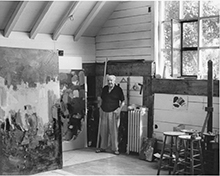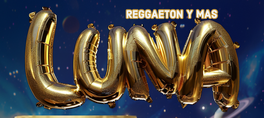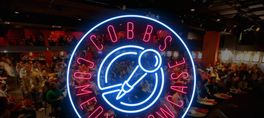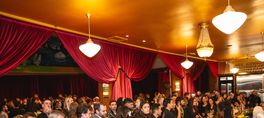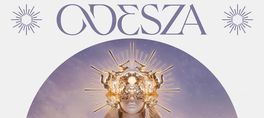In 1960 Hans Hofmann (1880–1966) described the just-completed painting Summer Bliss as one of his finest. At the suggestion of Erle Loran, then chair of the UC Berkeley Art Department, Hofmann offered Summer Bliss to the University in honor of professor Worth Ryder, who had passed away earlier that year. Ryder, who like Loran had studied with Hofmann years earlier in Germany, had invited Hofmann to teach at Berkeley in 1930, initiating what Hofmann later identified as his “start in America as a teacher and artist.”1
Three years later, Hofmann made another gift to the University—nearly fifty paintings representing the highest artistic achievement of his career, plus a pledge of $250,000 in support of the burgeoning University Art Museum (now BAM/PFA). At Hofmann’s request, Erle Loran was closely involved in choosing the paintings for this profoundly generous gift, selecting from among significant older works as well the strongest examples of his later practice. Although Hofmann died before the entire group was finalized, the BAM/PFA Hofmann collection, recognized as the world’s most extensive museum collection of his work, embodies the artist’s desire for it to be both excellent and comprehensive.
As we prepare to move to our new building in downtown Berkeley, it seems fitting to revisit the enduring vitality and generosity of Hofmann’s extraordinary gift. Hofmann by Hofmann focuses on the first paintings selected personally by Hofmann for BAM/PFA. Fantasia (1943), one of the earliest works, straddles a cusp between Surrealism and Abstract Expressionism while also anticipating the compositional logic and push-pull spatial dynamics of his signature color plane works of the 1950s and 1960s, such as Summer Bliss. In Nocturnal Splendor (1963) and Gloriamundi (1963), two of the later canvases, Hofmann employs contrasting colors and the arrangement of shapes into expanding and contracting forces (push-pull) to create the experience of three-dimensional space. “Space,” he wrote, “must be vital and active—a force impelled pictorial space, presented as a spiritual and unified entity, with a life of its own.”
1. Hans Hofmann to Erle Loran, 11 January 1961, The Bancroft Library, UC Berkeley.
Hofmann by Hofmann is organized by Lucinda Barnes, chief curator and director of programs and collections.
show less
Three years later, Hofmann made another gift to the University—nearly fifty paintings representing the highest artistic achievement of his career, plus a pledge of $250,000 in support of the burgeoning University Art Museum (now BAM/PFA). At Hofmann’s request, Erle Loran was closely involved in choosing the paintings for this profoundly generous gift, selecting from among significant older works as well the strongest examples of his later practice. Although Hofmann died before the entire group was finalized, the BAM/PFA Hofmann collection, recognized as the world’s most extensive museum collection of his work, embodies the artist’s desire for it to be both excellent and comprehensive.
As we prepare to move to our new building in downtown Berkeley, it seems fitting to revisit the enduring vitality and generosity of Hofmann’s extraordinary gift. Hofmann by Hofmann focuses on the first paintings selected personally by Hofmann for BAM/PFA. Fantasia (1943), one of the earliest works, straddles a cusp between Surrealism and Abstract Expressionism while also anticipating the compositional logic and push-pull spatial dynamics of his signature color plane works of the 1950s and 1960s, such as Summer Bliss. In Nocturnal Splendor (1963) and Gloriamundi (1963), two of the later canvases, Hofmann employs contrasting colors and the arrangement of shapes into expanding and contracting forces (push-pull) to create the experience of three-dimensional space. “Space,” he wrote, “must be vital and active—a force impelled pictorial space, presented as a spiritual and unified entity, with a life of its own.”
1. Hans Hofmann to Erle Loran, 11 January 1961, The Bancroft Library, UC Berkeley.
Hofmann by Hofmann is organized by Lucinda Barnes, chief curator and director of programs and collections.
In 1960 Hans Hofmann (1880–1966) described the just-completed painting Summer Bliss as one of his finest. At the suggestion of Erle Loran, then chair of the UC Berkeley Art Department, Hofmann offered Summer Bliss to the University in honor of professor Worth Ryder, who had passed away earlier that year. Ryder, who like Loran had studied with Hofmann years earlier in Germany, had invited Hofmann to teach at Berkeley in 1930, initiating what Hofmann later identified as his “start in America as a teacher and artist.”1
Three years later, Hofmann made another gift to the University—nearly fifty paintings representing the highest artistic achievement of his career, plus a pledge of $250,000 in support of the burgeoning University Art Museum (now BAM/PFA). At Hofmann’s request, Erle Loran was closely involved in choosing the paintings for this profoundly generous gift, selecting from among significant older works as well the strongest examples of his later practice. Although Hofmann died before the entire group was finalized, the BAM/PFA Hofmann collection, recognized as the world’s most extensive museum collection of his work, embodies the artist’s desire for it to be both excellent and comprehensive.
As we prepare to move to our new building in downtown Berkeley, it seems fitting to revisit the enduring vitality and generosity of Hofmann’s extraordinary gift. Hofmann by Hofmann focuses on the first paintings selected personally by Hofmann for BAM/PFA. Fantasia (1943), one of the earliest works, straddles a cusp between Surrealism and Abstract Expressionism while also anticipating the compositional logic and push-pull spatial dynamics of his signature color plane works of the 1950s and 1960s, such as Summer Bliss. In Nocturnal Splendor (1963) and Gloriamundi (1963), two of the later canvases, Hofmann employs contrasting colors and the arrangement of shapes into expanding and contracting forces (push-pull) to create the experience of three-dimensional space. “Space,” he wrote, “must be vital and active—a force impelled pictorial space, presented as a spiritual and unified entity, with a life of its own.”
1. Hans Hofmann to Erle Loran, 11 January 1961, The Bancroft Library, UC Berkeley.
Hofmann by Hofmann is organized by Lucinda Barnes, chief curator and director of programs and collections.
read more
Three years later, Hofmann made another gift to the University—nearly fifty paintings representing the highest artistic achievement of his career, plus a pledge of $250,000 in support of the burgeoning University Art Museum (now BAM/PFA). At Hofmann’s request, Erle Loran was closely involved in choosing the paintings for this profoundly generous gift, selecting from among significant older works as well the strongest examples of his later practice. Although Hofmann died before the entire group was finalized, the BAM/PFA Hofmann collection, recognized as the world’s most extensive museum collection of his work, embodies the artist’s desire for it to be both excellent and comprehensive.
As we prepare to move to our new building in downtown Berkeley, it seems fitting to revisit the enduring vitality and generosity of Hofmann’s extraordinary gift. Hofmann by Hofmann focuses on the first paintings selected personally by Hofmann for BAM/PFA. Fantasia (1943), one of the earliest works, straddles a cusp between Surrealism and Abstract Expressionism while also anticipating the compositional logic and push-pull spatial dynamics of his signature color plane works of the 1950s and 1960s, such as Summer Bliss. In Nocturnal Splendor (1963) and Gloriamundi (1963), two of the later canvases, Hofmann employs contrasting colors and the arrangement of shapes into expanding and contracting forces (push-pull) to create the experience of three-dimensional space. “Space,” he wrote, “must be vital and active—a force impelled pictorial space, presented as a spiritual and unified entity, with a life of its own.”
1. Hans Hofmann to Erle Loran, 11 January 1961, The Bancroft Library, UC Berkeley.
Hofmann by Hofmann is organized by Lucinda Barnes, chief curator and director of programs and collections.
show less
Date/Times:
Berkeley Art Museum and Pacific Film Archive (BAMPFA)
5 Upcoming Events
2155 Center Street, Berkeley, CA 94720
The Best Events
Every Week in Your Inbox
From Our Sponsors
UPCOMING EVENTS
Great suggestion! We'll be in touch.
Event reviewed successfully.
